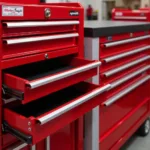A career-safe tool belt isn’t just about hammers and nails; in the automotive world, it’s about having the right diagnostic tools to tackle any problem. Whether you’re a seasoned mechanic or just starting out, having a reliable set of diagnostic tools is crucial for success and safety in today’s complex car repair landscape. This comprehensive guide will explore the essential tools that every automotive professional needs in their career-safe tool belt.
Essential Diagnostic Tools for a Career-Safe Tool Belt
Investing in the right diagnostic tools can be the difference between a quick fix and hours of frustration. These tools not only save you time and money but also ensure your safety and the safety of the vehicles you’re working on. Let’s delve into some must-have tools:
-
OBD-II Scanner: This is arguably the most important tool in your diagnostic arsenal. An OBD-II scanner allows you to communicate with your car’s computer, reading fault codes and providing valuable data about the vehicle’s systems. Choose a scanner that offers live data streaming and advanced features for a more comprehensive diagnosis.
-
Multimeter: A multimeter is your go-to tool for electrical troubleshooting. It measures voltage, current, and resistance, helping you pinpoint electrical faults and ensure the proper functioning of various components.
-
Test Light: A simple yet effective tool, a test light allows you to quickly check for power and ground in electrical circuits. This is essential for diagnosing wiring issues and identifying shorts or open circuits.
-
Pressure Gauge Set: From fuel pressure to tire pressure, a pressure gauge set is crucial for checking various systems. Accurate pressure readings are vital for diagnosing performance issues and maintaining the overall health of the vehicle.
 Essential Diagnostic Tools: OBD-II Scanner and Multimeter
Essential Diagnostic Tools: OBD-II Scanner and Multimeter
-
Stethoscope: A mechanic’s stethoscope allows you to pinpoint the source of unusual noises in the engine or other mechanical components. This can be incredibly helpful in diagnosing complex problems that are difficult to isolate.
-
Vacuum Gauge: A vacuum gauge measures engine vacuum, providing valuable insights into the engine’s internal health. It can help you diagnose issues like vacuum leaks, ignition problems, and valve timing issues.
-
Compression Tester: A compression tester measures the compression pressure in each cylinder, helping you identify problems with piston rings, valves, or head gaskets. This is a vital tool for diagnosing engine performance issues.
Why a “Career-Safe” Tool Belt Matters
A career-safe tool belt isn’t just about having the right tools; it’s also about using them correctly and safely. Proper training and knowledge are crucial for effective diagnostics and avoiding potential hazards.
-
Safety First: Using diagnostic tools incorrectly can be dangerous. Always follow the manufacturer’s instructions and take necessary safety precautions when working on a vehicle.
-
Accurate Diagnostics: The right tools, coupled with proper knowledge, lead to accurate diagnoses. This saves you time and money by avoiding unnecessary repairs.
-
Professionalism: A well-equipped tool belt demonstrates professionalism and builds trust with clients. It shows that you’re prepared to handle any diagnostic challenge.
Building Your Tool Belt Over Time
Building a comprehensive diagnostic tool belt doesn’t happen overnight. Start with the essential tools and gradually add more specialized tools as your needs and expertise grow. Consider investing in a car tool box set for a good starting point.
What are the essential tools for beginners?
For beginners, starting with an OBD-II scanner, a multimeter, and a test light is a good foundation. These tools cover the basics of electronic and electrical diagnostics. You might also consider a car belt tensioner tool for basic maintenance tasks.
What advanced tools should experienced mechanics consider?
Experienced mechanics might consider adding an oscilloscope, a lab scope, and specialized diagnostic software to their tool belt. These tools allow for in-depth analysis and troubleshooting of complex electronic systems. A 6 in 1 car tool can also be a versatile addition for a variety of tasks.
“A comprehensive diagnostic tool belt is an investment in your career. It empowers you to efficiently and safely diagnose car problems, ultimately leading to a more successful and rewarding career in the automotive industry,” says Robert Johnson, Senior Automotive Technician at Johnson Automotive.
“Never underestimate the importance of continuous learning in the automotive field. As technology evolves, so should your tool belt and your knowledge,” adds Sarah Miller, Lead Diagnostic Specialist at Miller Automotive Solutions.
Investing in a car engine support tool can also significantly improve your workspace safety. Moreover, a wide range of automotive car tools are available to suit specific needs and enhance your diagnostic capabilities.
In conclusion, a career-safe tool belt equipped with the right car diagnostic tools is essential for any automotive professional. It ensures safety, accuracy, and efficiency in diagnosing and repairing today’s sophisticated vehicles, ultimately contributing to a successful and rewarding career.
FAQ
- What is an OBD-II scanner?
- How do I use a multimeter?
- What is the purpose of a test light?
- Why is a pressure gauge set important?
- What can a mechanic’s stethoscope diagnose?
- How does a vacuum gauge help diagnose engine problems?
- What is the function of a compression tester?
For further assistance, please contact us via WhatsApp: +1(641)206-8880, Email: [email protected], or visit us at 910 Cedar Lane, Chicago, IL 60605, USA. Our customer service team is available 24/7 to assist you.
